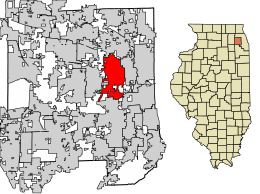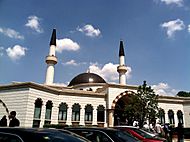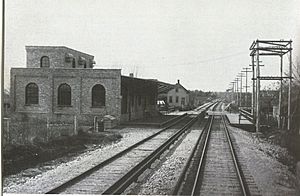Lombard, Illinois facts for kids
Quick facts for kids
Lombard
|
|||
|---|---|---|---|
| Village of Lombard | |||

Lilacia Park
|
|||
|
|||
| Nickname(s):
The Lilac Village
|
|||

Location of Lombard in DuPage County, Illinois.
|
|||
| Country | United States | ||
| State | Illinois | ||
| County | DuPage | ||
| Townships | York, Bloomingdale, Milton, Addison | ||
| Incorporated | 1869 | ||
| Government | |||
| • Type | Council–manager | ||
| Area | |||
| • Total | 10.41 sq mi (26.95 km2) | ||
| • Land | 10.22 sq mi (26.47 km2) | ||
| • Water | 0.19 sq mi (0.48 km2) 1.91% | ||
| Population
(2021 United States Census)
|
|||
| • Total | 44,476 | ||
| • Density | 4,351.86/sq mi (1,680.19/km2) | ||
| Up 2.5% from 2000 | |||
| Demonym(s) | Lombardian | ||
| Standard of living | |||
| • Per capita income | $40,832 (2019) | ||
| • Home value | $170,245 (median: $255,500 in Feb. 2021) | ||
| Time zone | UTC-6 (Central) | ||
| • Summer (DST) | UTC-5 (Central) | ||
| ZIP code(s) |
60148, 60149
|
||
| Area code(s) | 630 and 331 | ||
| Geocode | 44407 | ||
| FIPS code | 17-44407 | ||
Lombard is a village in DuPage County, Illinois, United States. It is a suburb of Chicago. In 2020, about 44,476 people lived there.
Contents
History of Lombard

The area where Lombard is now was once home to the Potawatomi Native American people. European settlers first arrived in the 1830s. Lombard shares its early story with Glen Ellyn. Two brothers, Ralph and Morgan Babcock, settled near the DuPage River. This area was known as Babcock's Grove. Lombard grew to the east, and Glen Ellyn grew to the west.
In 1837, a stagecoach line connected Babcock's Grove to Chicago. It stopped at Stacy's Tavern. Farmers were drawn to the area because of its rich land, the DuPage River, and lots of timber.
Sheldon and Harriet Peck moved here in 1837 from New York to farm 80 acres of land. Sheldon Peck was also an artist who painted portraits. The Peck house was the area's first school. Today, the Lombard Historical Society has restored it. In 2011, the Peck House was added to the National Park Service's Network to Freedom. This means it was a verified Underground Railroad location.
The Galena and Chicago Union Railroad arrived in 1848. This gave local farmers and businesses a way to send goods to Chicago by train. Soon, shops and other buildings appeared near the train station. Lombard officially became a village in 1869. It was named after Josia Lewis Lombard, a banker and real estate developer from Chicago.
Women's Right to Vote
On April 6, 1891, a brave woman named Ellen A. Martin led a group of women to the voting place. She demanded that the three male election judges let the women vote. The judges were so shocked that one of them fell into a barrel of flour! They finally agreed to let Ellen vote.
However, they didn't really want women to vote. So, a county judge was asked to decide. He agreed that the women were right. Ellen Martin then became the first woman in Illinois to vote. She was also one of the first in the entire U.S. In 1916, women in Illinois could vote in national elections. But the 19th Amendment, which gave all women in the U.S. the right to vote, wasn't passed until 1920.
In 2008, Lombard started celebrating "Ellen Martin Day" every April 6. This day remembers Ms. Martin's important victory for women's voting rights.
The Little Orphan Annie House
William LeRoy built a house in the Italianate style on Lombard's Main Street in 1881. LeRoy made artificial limbs for Civil War veterans. He lived in this house until 1900. Later, this house became the home of Harold Gray's parents. Harold Gray was the creator of the famous Little Orphan Annie cartoon strip.
Harold Gray used the study in this house to work on his Annie cartoons. Some parts of the house, like the grand staircase and the outdoor deck, were even drawn into his cartoons. Gray lived at 215 S. Stewart Ave in Lombard at this time. He later moved to the East Coast. Harold Gray was also one of the first members of the Lombard Masonic Lodge in 1923.
The Lilac Village
In 1927, Colonel William Plum, a local resident, left his estate to the village. His property included his home, which became the first Helen M. Plum Memorial Library. It also had a large garden with 200 different kinds of lilac bushes. This beautiful garden became a public park called Lilacia Park. This is why Lombard is known as "The Lilac Village."
Culture
Since 1930, Lombard has held an annual Lilac Festival and parade in May. "Lilac Time in Lombard" is a 16-day festival. It ends in mid-May. The festival begins with the crowning of the Lilac Queen. Many lilac-themed events take place. These include a formal ball, concerts, and wine and beer tasting in the park. There is also a Mother's Day Brunch, an arts and crafts fair, and tours of Lilacia Park. The festival ends with Lombard's Lilac Festival Parade. The first Lilac Princess in 1930 was Adeline Fleege.
A farmers market is held in downtown Lombard once a week. It runs from May to October each year. A food cooperative is also planned to open in town sometime in 2024.
Education
Lombard's high schools (grades 9-12) are part of Glenbard Township High School District 87. These schools are shared with the nearby town of Glen Ellyn. That's why the name "Glenbard" was created by combining "Glen" and "Lombard." Lombard's elementary and middle schools (grades K-8) are part of Lombard School District 44 or DuPage School District 45.
- High Schools
- Glenbard East High School (located in Lombard)
- This school serves most of Lombard.
- Glenbard South High School (located in Glen Ellyn)
- This school serves the far southwest part of Lombard.
- Glenbard West High School (located in Glen Ellyn)
- This school serves the far northwest part of Lombard.
- Willowbrook High School (located in Villa Park)
- This school serves the southeast and far northeast part of Lombard.
- Addison Trail High School (located in Addison)
- This school serves parts of Lombard that are not officially part of the village.
- Glenbard East High School (located in Lombard)
- Private Schools
- Montini Catholic High School
- College Preparatory School of America
Geography
Lombard is located at 41°52′34″N 88°0′54″W / 41.87611°N 88.01500°W. According to 2021 information, Lombard covers a total area of about 10.41 square miles (26.95 square kilometers). Most of this area, about 10.22 square miles (26.47 square kilometers), is land. The rest, about 0.19 square miles (0.48 square kilometers), is water.
Demographics
| Historical population | |||
|---|---|---|---|
| Census | Pop. | %± | |
| 1880 | 378 | — | |
| 1890 | 515 | 36.2% | |
| 1900 | 590 | 14.6% | |
| 1910 | 883 | 49.7% | |
| 1920 | 1,331 | 50.7% | |
| 1930 | 6,197 | 365.6% | |
| 1940 | 7,075 | 14.2% | |
| 1950 | 9,817 | 38.8% | |
| 1960 | 22,561 | 129.8% | |
| 1970 | 34,043 | 50.9% | |
| 1980 | 36,879 | 8.3% | |
| 1990 | 39,408 | 6.9% | |
| 2000 | 42,322 | 7.4% | |
| 2010 | 43,165 | 2.0% | |
| 2020 | 44,476 | 3.0% | |
| U.S. Decennial Census | |||
As of the 2020 census, Lombard had 44,476 people living in 17,030 households. The population density was about 4,274 people per square mile (1,680 people per square kilometer).
The village's population was made up of different groups. About 70.83% were White, 4.62% were African American, and 13.15% were Asian. About 10.17% of the population were Hispanic or Latino (who can be of any race).
About 20.4% of the people were under 18 years old. The average age in Lombard was 37.7 years. The median income for a household was about $86,167. This means half of the households earned more than this amount, and half earned less.
Economy
Lombard has many businesses that provide jobs. Here are some of the top employers in the village, based on a 2020 report:
| # | Employer | # of Employees |
|---|---|---|
| 1 | J.C. Penney Co. Inc. | 400 |
| 2 | School District 87 | 300 |
| 3 | Westin Lombard Yorktown | 275 |
| 4 | Adjustable Forms, Inc. | 250 |
| 5 | Vitas Healthcare Corporation | 250 |
Transportation
Lombard is served by Metra's Union Pacific West Line. This train line runs from the Ogilvie Transportation Center in Chicago to Elburn, Illinois. It uses the old Chicago and Northwestern Railway tracks.
Lombard is also connected by major highways. These include I-88 / Illinois 110 and I-355. Several Illinois Routes also pass through Lombard: 38, 53, 56, and 64.
In the past, Lombard also had trains from the Chicago Aurora and Elgin Railroad and the Chicago Great Western Railway. These old railway lines have now been turned into trails for walking and biking. These are called the Illinois Prairie Path and the Great Western Trail.
Pace provides bus service in Lombard. These buses connect Lombard to places like Naperville, Cicero, and other towns. The Yorktown Center is a main hub for bus routes in the area.
Notable people
Many interesting people have connections to Lombard:
- Winifred Bonfils, a newspaper journalist and writer.
- Dallas Frueh, a racing driver.
- Russ Gamester, another racing driver.
- Harold Gray, the cartoonist who created Little Orphan Annie.
- Tom Higgenson, founder of the band Plain White T's, who grew up in Lombard.
- Ellen Annette Martin, the first woman to vote in Illinois in 1891.
- Mary Elizabeth Mastrantonio, an actor.
- Sheldon Peck, a folk artist and someone who worked to end slavery.
- Mary Doria Russell, an author who wrote novels like The Sparrow.
- Bob Schacht, a racing driver.
- Daniel M. Tani, a NASA astronaut.
- Charles Tilly, a scholar.
- Doug Walker, a film critic and comedian.
- Timothy Zahn, a science-fiction author.
See also
 In Spanish: Lombard (Illinois) para niños
In Spanish: Lombard (Illinois) para niños





